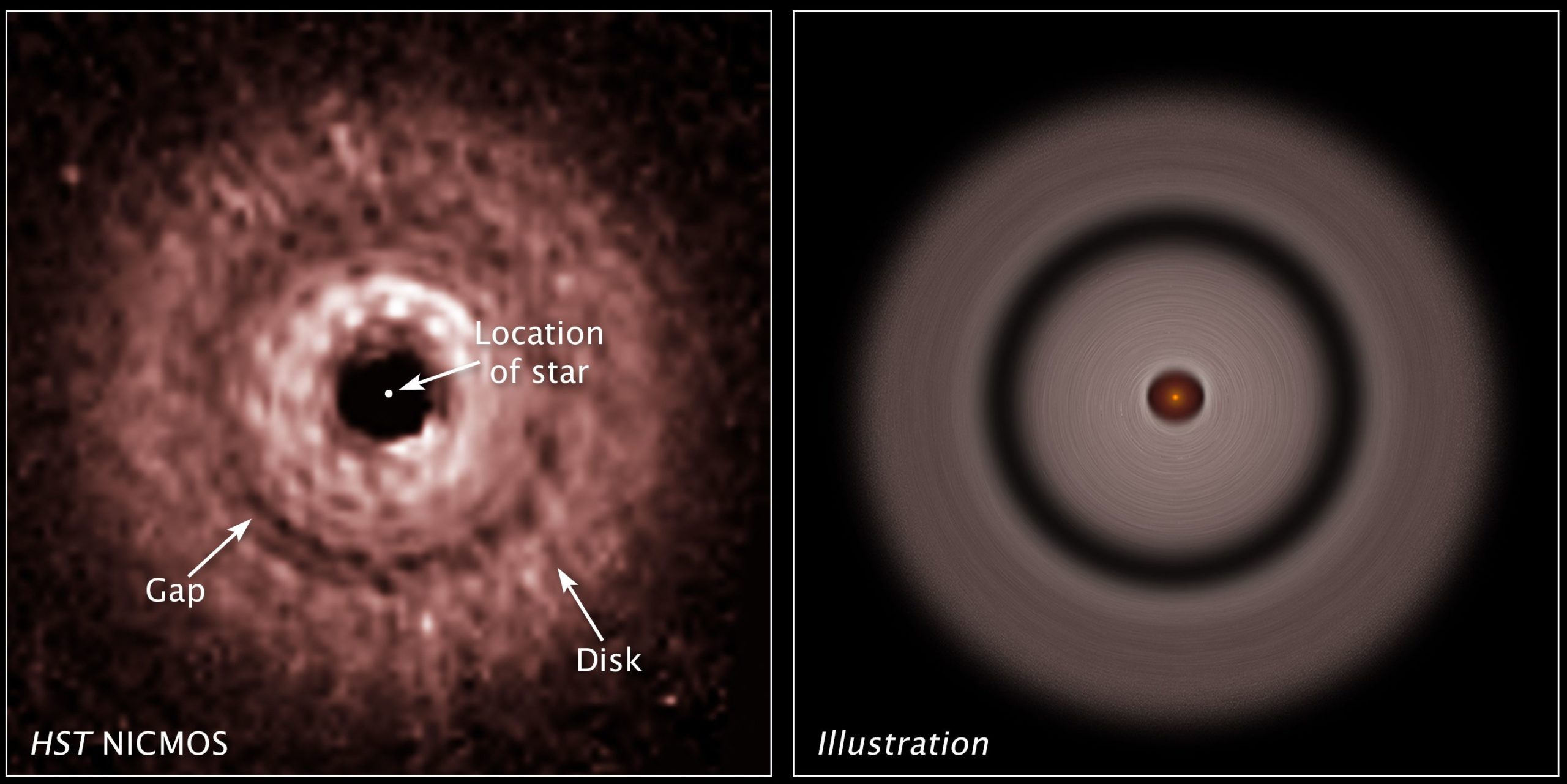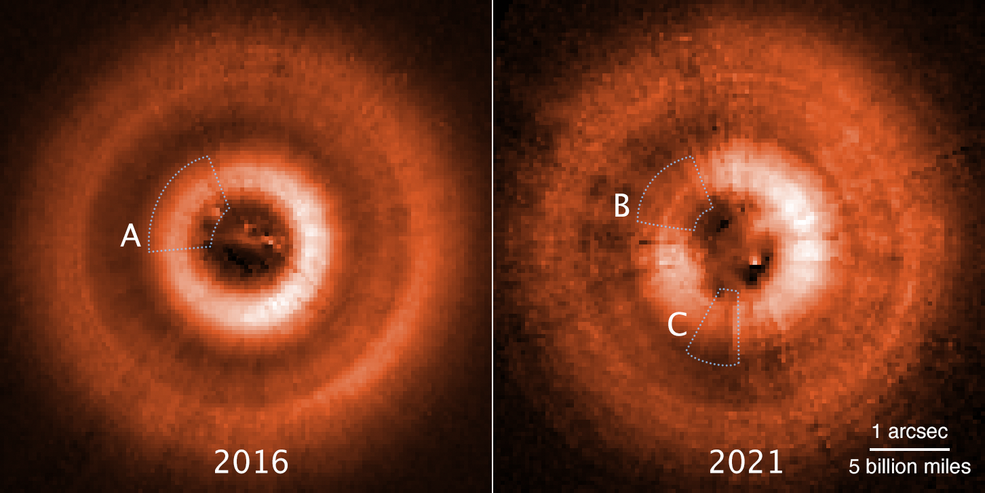The young star TW Hydrae is playing “shadow puppets” around the planet-forming disk with scientists observing it with NASA’s Hubble Space Telescope.
In 2017, astronomers reported discovering a shadow sweeping across the face of a vast pancake-shaped gas-and-dust disk surrounding the red dwarf star.
The shadow isn’t from a planet but from an inner disk slightly inclined relative to the much larger outer disk – causing it to cast a shadow. One explanation is that an unseen planet’s gravity is pulling dust and gas into the planet’s inclined orbit.
This artist’s concept is based on Hubble Space Telescope images of gas-and-dust disks around the young star TW Hydrae. Hubble Space Telescope photos show shadows sweeping across the disks encircling the system. The interpretation is these shadows are from slightly inclined inner disks that block starlight from reaching the outer disk, and therefore are casting a shadow. The disks are slightly inclined to each other due to the gravitational pull of unseen planets warping the disk structure. Image credit: Artwork: NASA, AURA/STScI for ESA, Leah Hustak (STScI)
Now, a second shadow – playing a game of peek-a-boo – has emerged in just a few years between observations stored in Hubble’s MAST archive. This could be from yet another disk nestled inside the system. The two disks are likely evidence of a pair of planets under construction.
TW Hydrae is less than 10 million years old and resides about 200 light-years away. In its infancy, our solar system may have resembled the TW Hydrae system, some 4.6 billion years ago. Because the TW Hydrae system is tilted nearly face-on to our view from Earth, it is an optimum target for getting a bull’s-eye-view of a planetary construction yard.
The second shadow was discovered in observations obtained on June 6, 2021, as part of a multi-year program designed to track the shadows in circumstellar disks. John Debes of AURA/STScI for the European Space Agency at the Space Telescope Science Institute in Baltimore, Maryland, compared the TW Hydrae disk to Hubble observations made several years ago.

This graphic shows a gap in a protoplanetary disk of dust and gas whirling around the nearby red dwarf star TW Hydrae, which resides 176 light-years away in the constellation Hydra, sometimes called the Sea Serpent. Image credit: NASA, ESA, J. Debes (STScI), H. Jang-Condell (University of Wyoming), A. Weinberger (Carnegie Institution of Washington), A. Roberge (Goddard Space Flight Center), G. Schneider (University of Arizona/Steward Observatory), and A. Feild (STScI/AURA)
“We found out that the shadow had done something completely different,” said Debes, who is principal investigator and lead author of the study published in The Astrophysical Journal.
“When I first looked at the data, I thought something had gone wrong with the observation because it wasn’t what I was expecting. I was flummoxed at first, and all my collaborators were like: what is going on? We really had to scratch our heads and it took us a while to actually figure out an explanation.”
The best solution the team came up with is that two misaligned disks cast shadows. They were so close to each other in the earlier observation they were missed. Over time they’ve now separated and split into two shadows. “We’ve never really seen this before on a protoplanetary disk. It makes the system much more complex than we originally thought,” he said.
The simplest explanation is that the misaligned disks are likely caused by the gravitational pull of two planets in slightly different orbital planes. Hubble is piecing together a holistic view of the architecture of the system.

Comparison images from the Hubble Space Telescope, taken several years apart, have uncovered two eerie shadows moving counterclockwise across a gas-and-dust disk encircling the young star TW Hydrae. The disks are tilted face-on to Earth and so give astronomers a bird’s-eye view of what’s happening around the star. The left image, taken in 2016, shows just one shadow [A] at the 11:00 o’clock position. This shadow is cast by an inner disk that is slightly inclined to the outer disk and so blocks starlight. The picture on the left shows a second shadow that emerged from yet another nested disk [C] at the 7:00 o’clock position, as photographed in 2021. The original inner disk is marked [B] in this later view. The shadows rotate around the star at different rates like the hands on a clock. They are evidence for two unseen planets that have pulled dust into their orbits. This makes them slightly inclined to each other. This is a visible-light photo taken with the Space Telescope Imaging Spectrograph. Artificial color, to enhance details, has been added. Image Credit: NASA, ESA, STScI, and John Debes (AURA/STScI for ESA); Image Processing: Joseph DePasquale (STScI)
The disks may be proxies for planets that are lapping each other as they whirl around the star. It’s sort of like spinning two vinyl phonograph records at slightly different speeds. Sometimes labels will match up but then one gets ahead of the other.
“It does suggest that the two planets have to be fairly close to each other. If one was moving much faster than the other, this would have been noticed in earlier observations. It’s like two race cars that are close to each other, but one slowly overtakes and laps the other,” said Debes.
The suspected planets are located in a region roughly the distance of Jupiter from our Sun. And, the shadows complete one rotation around the star about every 15 years – the orbital period that would be expected at that distance from the star.
Also, these two inner disks are inclined about five to seven degrees relative to the plane of the outer disk. This is comparable to the range of orbital inclinations inside our solar system. “This is right in line with typical solar system style architecture,” said Debes.
The outer disk that the shadows are falling on may extend as far as several times the radius of our solar system’s Kuiper belt. This larger disk has a curious gap at twice Pluto’s average distance from the Sun. This might be evidence for a third planet in the system.
Any inner planets would be difficult to detect because their light would be lost in the glare of the star. Also, dust in the system would dim their reflected light. ESA’s Gaia space observatory may be able to measure a wobble in the star if Jupiter-mass planets are tugging on it, but this would take years given the long orbital periods.
TW Hydrae: Key Facts
- TW Hydrae is named after its location in the constellation Hydra. The “TW” designation signifies that it is a variable star.
- It is a young T Tauri star, which means it is a pre-main-sequence star in its early stages of evolution.
- TW Hydrae is relatively close to Earth, located at a distance of about 176 light-years away.
- It is estimated to be only about 10 million years old, making it a relatively young star in astronomical terms.
- TW Hydrae has a radius of about 1.2 times that of the Sun, and it is slightly less massive than the Sun.
- It is known as a variable star, meaning its brightness changes over time. These variations in brightness can occur due to processes happening within the star or as a result of surrounding material.
- It is surrounded by a protoplanetary disk, which is a flattened disk of gas and dust. This disk is believed to be the birthplace of planets and other celestial objects.
- The presence of the protoplanetary disk around TW Hydrae has made it an important target for studying the process of planet formation. Astronomers have detected gaps and structures resembling shadows in the disk, indicating the possible presence of forming planets.
- In 2019, scientists announced the discovery of a potential exoplanet candidate orbiting TW Hydrae. This candidate, named TW Hydrae b, is estimated to be about 10 times the mass of Jupiter and is located relatively close to the star.
- This star is part of the TW Hydrae association, a group of young stars believed to have formed together from the same molecular cloud. This association provides insights into the early stages of stellar evolution.
Source: National Aeronautics and Space Administration

